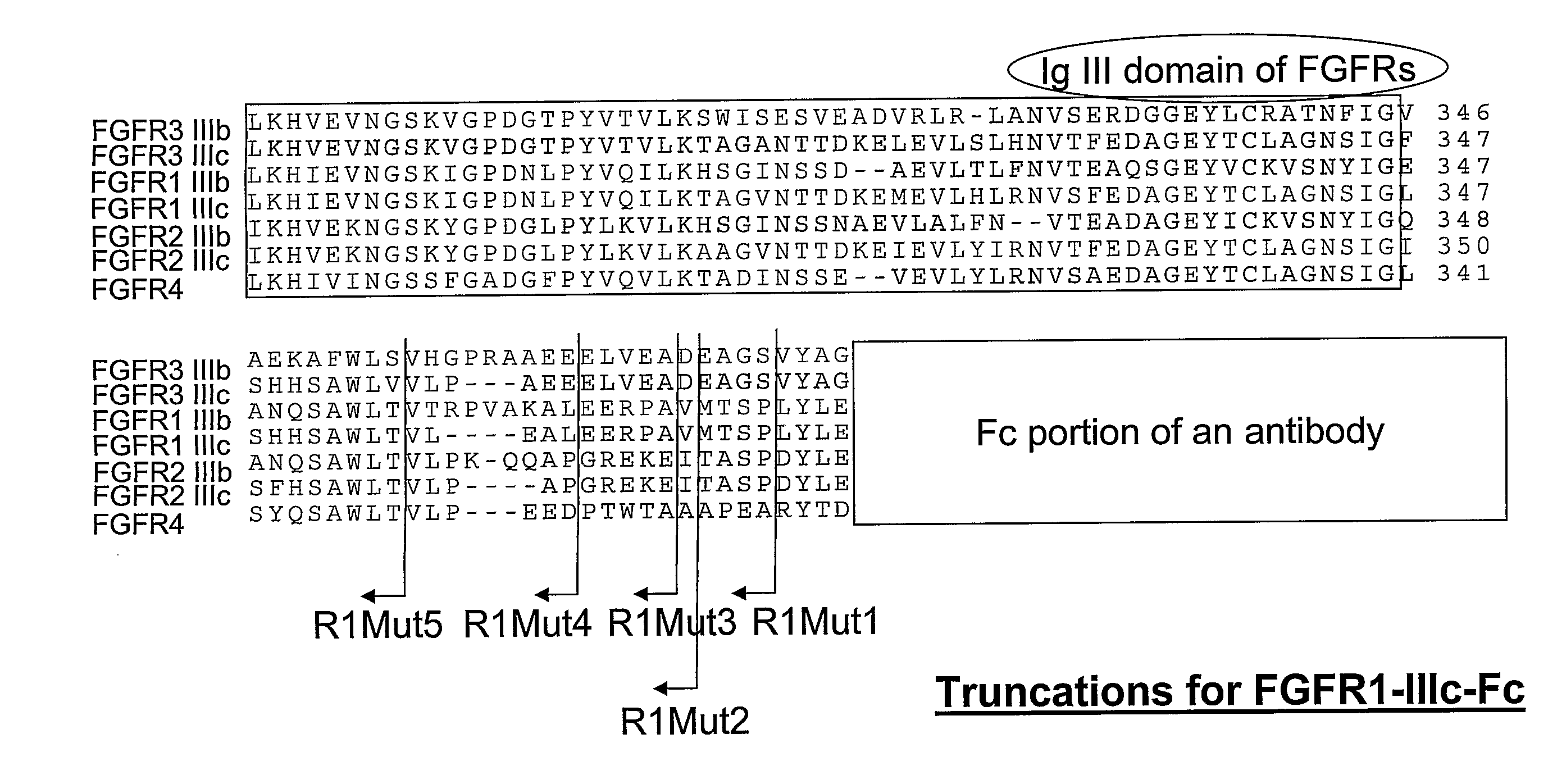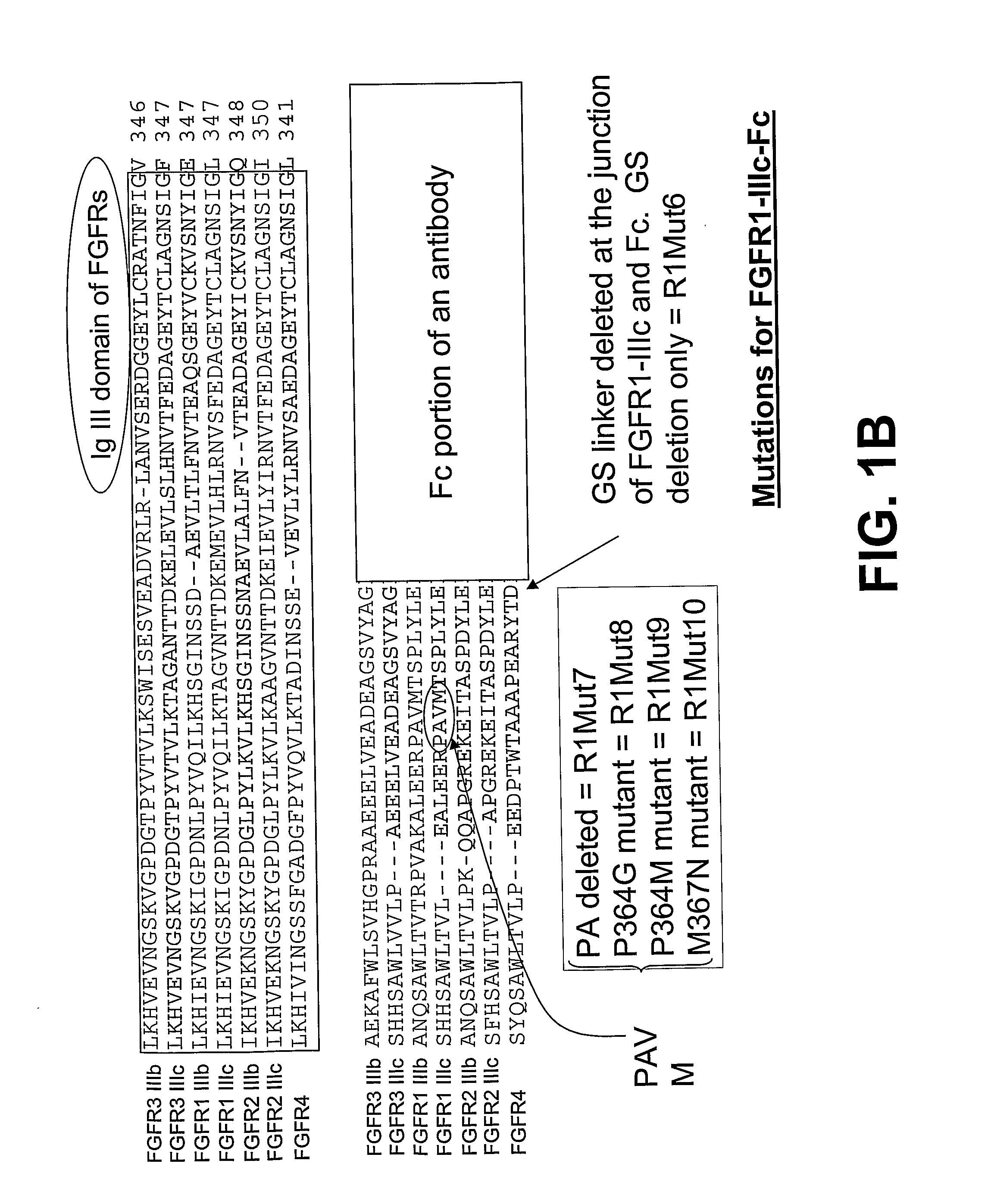Compositions and Methods of Treating Disease with Fgfr Fusion Proteins
a technology of fusion proteins and fibroblasts, applied in the direction of fusion polypeptides, peptide/protein ingredients, depsipeptides, etc., can solve the problems of patient safety, serum half-life, intracellular delivery, and the ability of specificity to be blocked by specific antibodies, so as to achieve less susceptible to cleavage
- Summary
- Abstract
- Description
- Claims
- Application Information
AI Technical Summary
Benefits of technology
Problems solved by technology
Method used
Image
Examples
example 1
Sequence Alignment of Partial IgIII Domains and the Membrane Proximal Regions of FGFRs and FGFR Variants
[0242]FIG. 1A shows an alignment of the amino acid sequences of a part of the IgIII domain of each of the seven FGFR family members, FGFR1-IIIb, FGFR1-IIIc, FGFR2-IIIb, FGFR2-IIIc, FGFR3-IIIb, FGFR3-IIIc, and FGFR4, using the Clustal W version 1.8 program of the European Molecular Biology Laboratory (EMBL) bioinformatics search site.
[0243]FIG. 1A also illustrates the organization of the parental FGFR1-IIIc-Fc fusion protein (nucleotide SEQ ID NO: 4, protein SEQ ID NO: 95) and corresponding mutants. The IgIII domain is followed by the C-terminal portion of the ECD, which is followed by the Fc portion of an antibody. The alignment marks the truncation locations of the R1Mut1 (nucleotide SEQ ID NO: 6, protein SEQ ID NO: 97), R1Mut2 (nucleotide SEQ ID NO: 7, protein SEQ ID NO: 98), R1Mut3 (nucleotide SEQ ID NO: 8, protein SEQ ID NO: 99), R1Mut4 (nucleotide SEQ ID NO: 9, protein SEQ ID...
example 2
Expression of FGFR Fusion Proteins
[0246]The fusion proteins of the invention were expressed in 293-6E host cells using the pTT5 vector (Biotechnology Research Institute; Montreal, Canada) transfected into 293-6E cells (Biotechnology Research Institute; Montreal, Canada), which were then cultured to produce the fusion proteins. An expression vector that comprised the cDNA of FGFR1-IIIc-Fc (SEQ ID NO: 4), encoding the extracellular domain of human FGFR1-IIIc (SEQ ID NO: 1) was constructed from an open-reading frame cDNA library prepared internally. This cDNA was linked at its C-terminus through a linker encoding the amino acids GS to cDNA encoding an Fc fragment of human IgG1 heavy chain (SEQ ID NO: 80) to produce a fusion construct hereafter referenced as “FGFR1-IIIc-Fc cDNA” and the expression product thereof as “FGFR1-IIIc-Fc protein.” The Fc fragment was also obtained from an open-reading frame cDNA library prepared internally. This cDNA fusion construct was inserted into a pTT5 v...
example 3
Transient Expression of Fusion Proteins in 293-6E Cells and CHO-S Host Cells
[0255]The FGFR1-IIIc-Fc / pTT5 expression vector was designed to provide transient expression in 293-6E host cells. The 293-6E cells were previously adapted to serum-free suspension culture in Free-Style medium (Invitrogen; Carlsbad, Calif.). The cells were transfected with the expression vector while in logarithmic growth phase (log phase growth) at a cell density of between 9×105 / ml and 1.2×106 / ml.
[0256]In order to transfect 500 ml of cell suspension, a transfection mixture was first made by mixing 500 micrograms (ug) of the expression vector DNA in 25 milliliters (ml) of sterile phosphate buffered saline (PBS) with 1 milligram (mg) of polyethylenimine (at a concentration of about 1 mg / ml solution in sterile water) in 25 ml of sterile PBS. This transfection mixture was incubated for 15 min at room temperature. Following incubation, the transfection mixture was added to the 293-6E cells in log phase growth to...
PUM
| Property | Measurement | Unit |
|---|---|---|
| Time | aaaaa | aaaaa |
| Dimensionless property | aaaaa | aaaaa |
| Mass | aaaaa | aaaaa |
Abstract
Description
Claims
Application Information
 Login to View More
Login to View More - R&D
- Intellectual Property
- Life Sciences
- Materials
- Tech Scout
- Unparalleled Data Quality
- Higher Quality Content
- 60% Fewer Hallucinations
Browse by: Latest US Patents, China's latest patents, Technical Efficacy Thesaurus, Application Domain, Technology Topic, Popular Technical Reports.
© 2025 PatSnap. All rights reserved.Legal|Privacy policy|Modern Slavery Act Transparency Statement|Sitemap|About US| Contact US: help@patsnap.com



